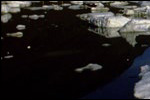|
Background
When evaluating the impact
a large decision such as whether or not to drill in the Arctic
National Wildlife Refuge (ANWR) will have on a region, the
sociological implications of the action must be taken into
consideration. Since the current situation is already known
and would not change drastically if no drilling occurred,
our research focused on what would happen if drilling was
allowed. Though people throughout the world will be affected
by drilling, the people of Alaska are nearest to the heart
of the issue and will therefore bear the major effects of
oil drilling. We looked at four major groups in Alaksa; the
Native Alaskans, the citizens, and Native Corporations, and
the environmentalists that reside in Alaska.
The people who have lived in Alaska the longest are the native
tribes. In the ANWR area of Alaska, there are two main tribes
- the Gwich'in and Inupiat. The larger Gwich'in tribe subsists
mainly on land animals, especially the caribou, and would
be adversely impacted by the effects oil drilling would have
on these species. In contrast, the Inupiat support drilling
because the money it would bring in would allow them to modernize
many aspects of their life. Since their diet is primarily
one of sea animals, their food source would not be seriously
affected by onshore drilling.
Research done on the impact of oil on the rest of Alaska's
citizens suggests that such activities may be beneficial in
the short-term but detrimental in the long run. Certainly,
jobs would be created, but these would be temporary and would
expire as quickly as the oil disappeared. Congressional power
of the state would rise with increasing oil production, but
most estimates conclude that no oil would appear on the market
for at least ten years. The eventual influx of new wealth
appeals to many of Alaska's citizens, and that is why the
majority of the people of Alaska support drilling.
Those who play roles in the corporations and government of
Alaska will also be impacted by oil drilling in the 1002 region.
There are two different types of corporations, and each has
a different view on drilling. The corporations owned by the
natives must keep an eye out for the health of the people
and the local environment, so they support looking for other
places to drill. On the other hand, outside corporations,
including the oil companies, are seeking to drill in ANWR
to increase their profits while creating short-term jobs for
the local communities.
Finally, Alaskan environmental groups, who of course oppose
all drilling, will be affected by drilling. If such activities
are allowed, most groups have vowed to issue time and money
consuming litigation which will slow the actual start of drilling.
This litigation will either increase or decrease the power
of these green groups, depending on how it is depicted by
the media. Either way, these groups will try their hardest
to oust any drilling from the region if it becomes a reality.
In evaluating the total impact of this decision on the people,
it was found that there would be several negatives and positives.
These effects will be factored into the cost-benefit analysis
to determine the overall impact of drilling on Alaska. While
no amount of research can correctly ascertain the true impact
of future drilling, one can be assured that the sociological
implications will be great.
[top]
|





